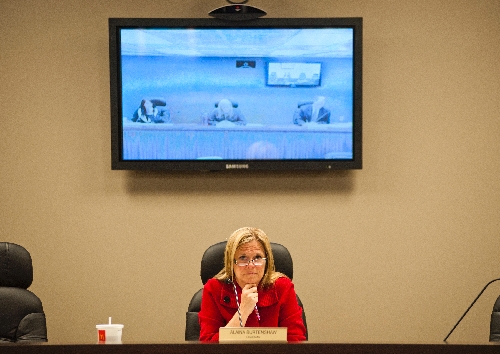Regulators pull plug on NV Energy’s conservation program

The Public Utilities Commission of Nevada zapped NV Energy’s conservation program Thursday.
The board cut the utility’s annual energy-efficiency budget from $73 million to $52 million. Affected were refrigerator recycling, lighting programs and weatherization aid for low-income households.
Despite the cut, NV Energy executives said they still have a lot to work with.
“What’s important is we still have a robust portfolio of programs we’re rolling out for customers,” said Larry Holmes, NV Energy’s manager of customer strategy and programs.
The $52 million budget “is not chump change. We’re excited about being able to take our programs to customers, and to help them manage their bills and energy usage.”
Other efficiency stakeholders weren’t happy about the decision.
The Southwest Energy Efficiency Project, an advocacy group that collaborates with utilities and state agencies to promote power conservation in six Western states, and the nonprofit Nevadans for Clean Affordable Reliable Energy asked the commission to approve the $73 million program.
The groups said in a joint statement they were “deeply disappointed” with the ruling. Households across Nevada will pay millions more for power because ratepayers will purchase less energy-efficient appliances and light bulbs, they said. And there will be fewer jobs statewide in businesses that produce, market and install energy-efficient goods.
“The PUC was penny-wise but pound-foolish in its decision today, and consumers in Nevada will pay the price through higher utility bills,” said Steve Wiel, Nevada representative for the Southwest Energy Efficiency Project.
The commission cited several reasons for program reductions.
Commissioners cut the second-refrigerator recycling program from a requested 8,850 units to 6,325. Through the program, NV Energy picks up fridges in garages, recycles them and rebates $50 to owners.
The problem? Many consumers who would have dumped their second fridge anyway get a rebate. People usually put their existing fridge in their garage when they upgrade to a new one in the kitchen; in many cases, the new appliance deliverer would have hauled away the old one for free.
The commission’s decision left the program at 2010 levels, an amount that “continues market momentum while providing time for (the company) to modify the program to noticeably reduce free-ridership rates.”
The commission also suspended NV Energy’s lighting program, through which the utility worked with makers of compact fluorescent bulbs (CFLs) to cut bulb prices by roughly half in some home-improvement stores.
But lighting also had free-ridership issues, as many consumers who purchased CFLs might have done so even without the price cut. Plus, a new state law banning 60-watt incandescent bulbs raised questions for commissioners.
“It is unclear how the change in lighting efficiency will affect ratepayers’ buying behaviors, retailers’ lighting offerings or producers’ manufacturing as they relate to general-purpose lighting,” the commission’s order said. “Given this uncertainty, the commission finds that it is reasonable to wait and see what happens in response to the new standard.”
Moving forward now “creates a risk that ratepayers will unnecessarily invest in market transformation that will occur absent the program,” the order added.
Low-income weatherization programs fell victim to falling natural-gas prices.
Natural gas fuels more than 70 percent of NV Energy’s power generation, so lower prices mean slumping electricity costs.
NV Energy last drew up low-income weatherization plans when natural gas cost $10 a decatherm. Today, gas costs about $2.50 a decatherm. It’s good for customers to use less energy, but helping them do so isn’t cost-effective anymore, Holmes said.
Some of the programs will come back in altered forms in later years, Holmes said. For example, the company will turn its lighting efforts toward initiatives involving light-emitting diode (LED) bulbs, with new programs available in a few years, Holmes said. And NV Energy will continue to study making low-income weatherization more economically viable.
Unaffected in Thursday’s ruling were incentives for residential customers who replace electric water heaters with solar thermal units, efficiency-education programs, grants to help nonprofits conserve, incentives to include energy-efficiency measures in new commercial buildings and programs to curb peak power use in schools.
Contact reporter Jennifer Robison at jrobison@reviewjournal.com or 702-380-4512.












